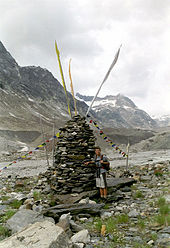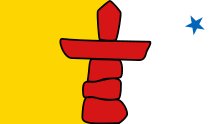Cairn


Steinmännchen , Steinmänner , Steinmandl or Steinmanderl , also stone doves , are stones stacked on top of one another in the form of small hills or turrets. They are an archaic form of the signpost , but are still being erected around the world today. The marking is intended to facilitate orientation , particularly in impassable and confusing terrain - such as mountains , high mountains , steppes and deserts . Stone men are common in all populated areas of the world. Other, often religious, customs are associated with them in various cultures. These markings are to be distinguished from sometimes similar looking barrows and cairns ; in some languages (such as English or French), stone men are also referred to as cairns . This type of stone pile is also to be distinguished from the so-called stone balance , which has no other purpose other than aesthetic.
Stone men in the Alps and as landmarks


Although in the Alps by the today alpine clubs , many platforms are designated by color markings and signs, there are still numerous walkways , paths and transitions that are marked only with a few cairns.
Large stone men are often erected as a summit sign instead of a summit cross . Sometimes they are solidified with cement and have a memorial plaque for those who died or died. In some places in the Alps you can find regular cairn gatherings, which are not for orientation, but rather form Land Art (e.g. on the Schafreuter in the Karwendel, on the Beiljoch in the Stubai Alps , the Auenjoch in the Sarntal and the Luibisboden , an abandoned alpine pasture in the middle Pitztal ).
Some surveying points located on peaks are also signaled with cairns if an accuracy of about 10 cm is sufficient and the point is difficult to reach. They have to be at least one, better two meters high to be visible far enough and even with poor contrast. Building such a stone pyramid from rubble stones as symmetrically as possible takes several hours of work.
In the mountains of the Near East and South America , numerous points in the first-order basic network are also marked with stone symbols in order to save the effort of building surveying pillars. The achievable accuracy is usually sufficient for the surveying needs in developing countries .
Typical stone men
A stone man usually consists of larger stones stacked in an approximately conical shape with at least three layers, since such an arrangement is unlikely to be a chance result of natural forces. There are also cylinder- shaped buildings, but they are less stable and therefore lose their function more quickly.
Usually a stone man is between 0.5 and 1.5 meters high, and higher in prominent places. Today they help hikers in particular to stay on the right path. In earlier times, when there were often hardly any roads and only wagons in inaccessible regions , cairns marked paths from village to village or pass paths over mountain ridges. Especially in fog and dense clouds, when the surrounding area was veiled and offered little orientation, and also when there was snow cover, they were often vital - especially since some paths were the only safe crossings that you couldn't miss. Stone men have been maintained by locals for generations.
Stone men in different cultures
Already in ancient Greece , cairns laid out as path markers were given an additional cultural meaning. From them developed Hermen , at crossroads-scale cult images of Weggottes Hermes whose name begins with the ancient Greek term for a cairn hermaion in communication.
According to a Norwegian tradition, the hiker should put a stone on every stone man (norweg. Varde) in order to remain unmolested by trolls . Even today, hikers are encouraged to use one or more stones to help maintain the signposts with at least partially worn or damaged cairns (not only those on the mountain peaks). However, tourists erect cairns in many places that have no function as path markers. This behavior was described as a nuisance on the Norwegian broadcaster NRK in 2015 .
In Sweden , cairns also serve as border markers under the name Reichsrösen ( riksrösen ).
In Iceland , the meaning is controversial. Some actually consider them to be talismans to protect against trolls (probably better to protect against storms), others claim that they are used for orientation in fog, which is very common in Iceland. Originally, these stone towers were actually within sight of each other, but have mostly fallen into disrepair over the centuries. Exact research continues.
Inuit cultures
With the Eskimos in the Arctic , Inuksuk (called cairns in Inuktitut , the language family of the Eskimos) have a variety of marking functions and point to important places. An Inuksuk with two separated legs on a bank indicates a navigable canal, an Inuksuk on a lake indicates good fishing grounds at the marked point and as far in the lake as the cairn is from the bank.
Of note is the use of Inukshuk as a "helper" in the hunt on reindeer . The Eskimos built rows of cairns with "hair" made of reindeer lichen ; Rushed by a few people, the animals were driven directly towards the hunters' pack, so that even small hunting communities could kill fast ungulates in largely open terrain.
An inuksuk was also the logo of the 2010 Winter Olympics in Vancouver , Canada .
North America
In various Indian cultures in the southwestern United States and adjacent areas, large stone structures were created in places that were used for worship and prayer, in addition to piles of stones of various sizes to mark paths. The Navajo tradition developed that every hiker puts some leaves on top of such a pile of stones and weighs them down with a new stone.
South America
Piles of stones are widespread throughout South America and are known there under the name Apacheta . They mark paths and serve as places of worship in honor of the deity Pachamama .
Middle East
The Dominican Felix Fabri observed on his pilgrimage to the Holy Land and Mount Sinai in 1483 :
“The pile of stones on the summit was a signpost, because everywhere in the desert there are piles of stones piled up on mountain peaks that indicate which valleys you have to go through; and if these signs did not exist, no one could go through the desert, because most of the larger valleys are not continuous but close at the ends, and so, after walking the valley for three or four days, one would be at last forced to turn back. It is the same with a cliff-rich sea; piles of stones are set up on heights as navigation marks; and if they did not exist, many ships heading for the cliffs would run on sandbanks or get caught in whirlpools. Many people would perish here too if these symbols were not on the mountains. "
Central Asia
In Central Asia, too, cairns can be found in historical places, for example in the ruins of the Buddhist monastery Kara Tepa on the Uzbek-Afghan border. In the Mizdakkhan necropolis on the Karakalpakisch - Turkmen border, the cairns represent the pillars of a mosque ruin. In the old part of Köneürgenç there are many cairns, especially near the Mamuns II minaret.
Tibet
In Tibet , both in the old Bon religion and in the Buddhist popular belief, cairns have acquired a religious meaning in addition to their function as path markers. A distinction must be made between the Lhathos and the Lhadses :
- Lhathos ( lha tho , lha denotes so-called gods) are regular stone settings that always taper at the top. They are often adorned with prayer flags , wool ribbons, animal horns or entire skulls of ibexes. In the case of lhathos painted with white lime paint , the faithful ask good spirits to take up residence in the cairn. Red lhathos are said to attract angry spirits that can scare off evil influences.
- A Lhadze is mostly irregularly shaped, traditionally with a tuft of brushwood on the tip and also decorated with prayer flags. It serves as the residence of the local protective spirit of a family, a monastery or a village. Both Lhathos and Lhadses are often associated with individual or collections of mani stones . In the same region there are also the stone settings called obo , which come from the Lamaist tradition of Tibet and Mongolia .
Western cultures
In western cultures, cairns are erected in prominent locations. They serve hikers as an expression of their solidarity with the place, the identification with traditions and as a symbolic possession of the environment. In areas that are heavily used by tourism and recreation, large groups of cairns are often set up, which have no function as signposts. If this happens in places where there are no thick layers of stone and gravel, it can lead to conflicts with nature conservation because stones are removed from their natural position where they were used to strengthen the ground. Any change in the natural landscape is undesirable in wilderness areas.
See also
literature
- Richard Andree: Ethnographic Parallels and Comparisons . Maier, Stuttgart 1878.
- Hans Haid : Myth and Cult in the Alps . Edition Tau, Bad Sauerbrunn 1990, ISBN 3-900977-08-9 .
Web links
Individual evidence
- ↑ Otto Holzapfel : Lexicon of Occidental Mythology , entry Hermes , Freiburg i. Br. 1993, ISBN 3-451-22487-9 , p. 195
- ↑ Ulovlige varder er blitt en farsott (illegal cairns have become a plague)
- ↑ Steven C. Jett: Cairn Trail Shrines among the Navajo, Apache, and Puebloans, and in the Far North . In: David T. Kirkpatrick and Mehila S. Duran (Eds.): Collected Papers in Honor of Gordon Page , The Archaeological Society of New Mexico, Papers 20, 1994
- ↑ Stephen C. Jett: Physical Characteristics of Navajo Trails, Canyon de Chelly Area, Arizona . In: Material Culture , Vol. 26, No. 1 (Spring 1994), pp. 37-48, 45
- ↑ Apacheta
- ↑ Brigitte Kramer: Tourist ritual disrupts Mallorca's ecosystem. Stone almonds are prevalent on Spain's beaches. In: The Standard . September 7, 2017. Retrieved September 8, 2017 .
- ^ Charles Jacobi: An Experiment Using Signs to Reduce Visitor-Built Cairns in Acadia National Park (PDF; 99 kB). National Parks Service, 2003


